Chengdu, which is drooling and missing, uses its memory to sting its skin in the crisscross time and space between old and new

I have been in Chengdu since I remembered it until I graduated from college. Although I was not born in Chengdu, I always said that I am "old Chengdu". After all, I grew up within the First Ring Road. At that time, we called the First Ring Road "Little Chengdu".
At that time, there was also a primary school in Qingshiqiao, which was my alma mater; I walked 10 minutes to school every day. After school, I would always surround the old lady selling kohlrabi at the school gate with my friends and spend a few cents to buy a few strings of delicious kohlrabi, and then happily go home to do homework. Nowadays, I have never seen the kind of kohlrabi sold before, which were strung together and then dipped in the seasoning until the soup drips, but the taste is still there.
Later, we liked to eat sweet but not greasy fruits, which were sold for 1 or 2 yuan each. We ate them until our mouths were sweet and we were reluctant to lick them off with two white sesame seeds on the corners of our mouths. In my middle school, on Dongchenggen Street, there are two big ginkgo trees at the entrance of the school. Every time when the ginkgo is ripe, we will pick up the ginkgo trees underground and eat them. I always feel that the egg cakes at that time, whether they are filled with white sugar and sesame seeds or stuffed with pickled mustard tuber meat, are very delicious. The old man who sells the egg cakes with a cart is very amiable.
Later, when he was in college, he began to eat Guanghua Village's malatang, skewers, and rabbit heads...
Later, after graduating from college, I left Chengdu. Until now, I return to Chengdu several times a year. My emotions are still related to eating, and I can never forget the bite in front of my home. The various plots of old Chengdu are like countless memories strung together in my mind. Wandering around in my mind, allowing me to look again and again after returning to Chengdu...
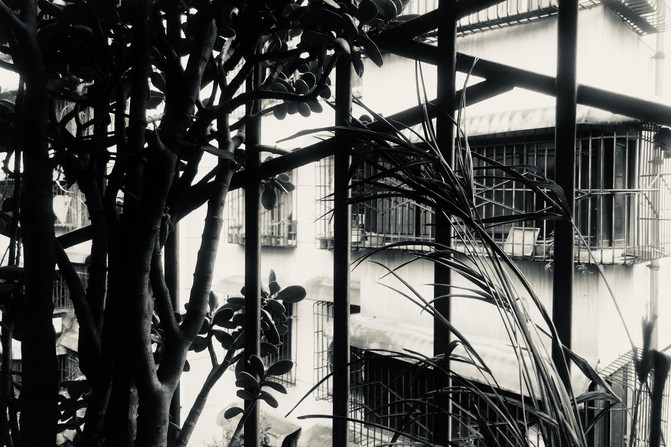
Memories of old Chengdu can still be found in these places
My parents stubbornly live in an old house 5 minutes 'walk from Tianfu Square. The old house without elevators is obviously not suitable for their awkward legs and feet. However, you can meet old friends playing mahjong through the alleys, as well as small shops that are used to buying and eating on the roadside, as well as a vegetable market that sells everything across the overpass. The atmosphere still retains the flavor of old Chengdu, allowing them to "stay" in a corner of the downtown area.
It has been a habit for decades that after dinner, my parents will go for a walk in People's Park; or on a cool autumn day, they will meet old friends to go to Heming Teahouse to drink tea and play mahjong.
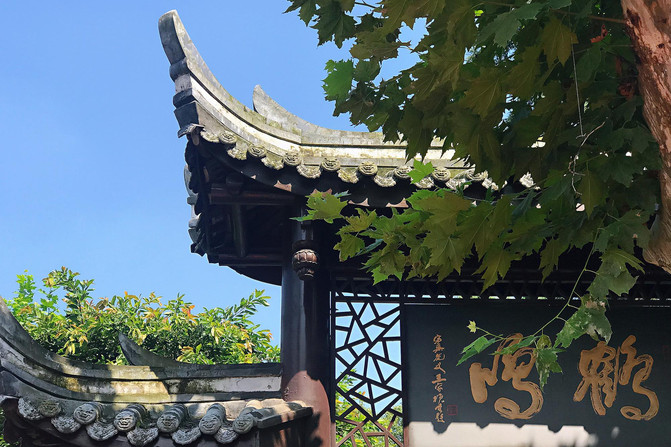

It is said that Chengdu people have three spaces. The first space is "home", the second space is "unit", and the third space is "teahouse". Leisure and comfortable teahouse can "store spirit and soul."
In the "Heming Teahouse", the small bowl is a microcosm of Chengdu's lively and fragrant life. Drinking tea, playing cards, chatting, and picking ears are all interesting in Chengdu people's leisure way; bamboo shadows, flowing water, calligraphy and painting, and history are all features of Heming Teahouse that attract locals and outsiders to linger...


Since my brother's home was settled in the eastern suburbs,"Eastern Suburb Memories" has become a place my father and I frequented. Every time I go to the eastern suburbs to remember, my father will feel a lot of emotion.
The memories of the eastern suburbs are full of reminiscing about the history of their fathers from the 1950s and 1970s; it was a story of Chengdu's old industry and a distant era. My father told me that at that time, wearing Dacron, carrying semiconductors, and riding a permanent bicycle to work at the Dongjiao National Defense Plant were the biggest dreams of people born in the 1950s...
A cup of green tea, from hot to cold, records a beautiful period; a column of fragrance, curling out, remembers a period of time; an hourglass, where the fine sand flows out, tells a story...


Today, it has become a check-in spot for "Internet celebrities" in the east of Chengdu, where diverse cultural forms such as art, music, photography, and drama coexist. At the same time, the "Eastern Suburb Memory" of our fathers will also stay here forever!


If the memory of the eastern suburbs was rebuilt on the basis of the "industrial base built on the third line", then the Yuanyang Building of Sichuan University is completely a microcosm of Chengdu in the 1960s and 1970s.
Stepping into the lintel 40 years ago is like walking into a Wong Kar-wai movie: you can see the old and devastated at a glance, the dilapidated doors and windows, the messy furniture, and you can even smell the aroma of food...

Yuanyang Building used to be an old dormitory for Sichuan University faculty and staff. Now, in addition to a few residents at that time, it has basically become a small place for rental housing, with many young people and migrant workers living in it.
I don't know when, this building, which is a representative of old Chengdu, has become a holy place for online celebrity photography for fashionable young people. Too many foreign photographers have more or less disturbed the peace of the residents. However, it is the fireworks atmosphere of the city that allows people to find the true charm of old Chengdu!


Zhimin Road, a food street in memory
In Chengdu, in the end, it's still eating, leaving the taste of saliva that you miss. Zhimin Road is not far from my home. During the day, it is a gentle and elegant old street in urban Chengdu, exuding leisurely and containing the slow time of Chengdu people. When night falls, it is adjacent to the most lively nightlife gathering area in Chengdu-Jiuyanqiao Beer Street, which jointly supports Chengdu people's eating and drinking in the middle of the night.
Chengdu eaters-creative and delicious Chengdu local dishes
Among the rows of restaurants at No. 46 Zhimin Road, the restaurant for Chengdu diners is not big and does not look impressive. However, it has a reputation. I heard that a diehard fan threatened to "fly to Chengdu to eat every six months." It can be said that it is a mythical existence in the restaurant.

When we went there, we specially chose noon, but we didn't expect that we would have to wait in line for a long time. The decoration of the restaurant is much more atmospheric than the facade. There are still many elements of old Chengdu that can be explored, but there are really many people, and the seats for four people seem a little cramped. One of the advantages of eating in this kind of restaurant is that you don't have to worry about ordering at all. As long as you look at what the tables next to you order, it's definitely right to follow.

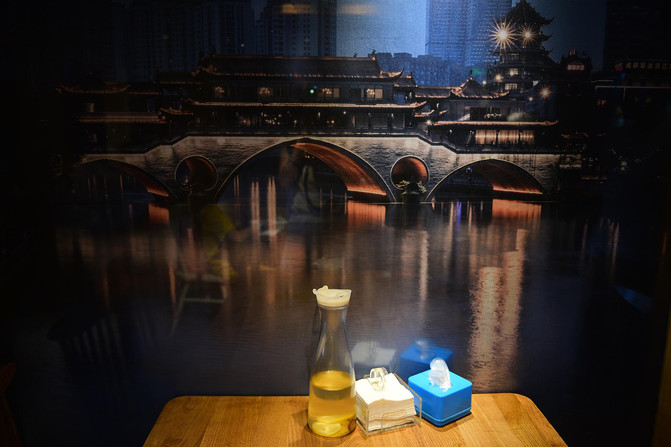
Special grilled fish slices: The thin slices of tender fish skewers are roasted fragrant with bamboo sticks. The inside is full of surprises and pineapples are used to relieve the boredom; it is just right with pickled cabbage fish soup. Eat two fish. It is sour, spicy and delicious.


Duck sausage dipped in water: In recent years, the essence of Sichuan cuisine has been reflected in dipped vegetables. The dishes must be fresh to maintain good taste after being boiled in white water. The preparation of dipped water must also be spicy and moderately salty to satisfy the picky tastes of Chengdu people. You can imagine how much effort it will take for the chef to consume this water-dipped duck sausage that comes on display.

The Nestle Palm Treasures with high hanging branches are extremely attractive. Quail eggs and Palm Treasures are all well laid down among the dried peppers, making it a must-order at almost every table.

Mandarin duck boiled beef is definitely recommended. This was the first time I had eaten a relatively light boiled beef. I didn't expect the taste to be surprisingly good, especially when dripping with oil. The sizzling sound not only made the beef boil but also made me wait for the eater's saliva dripping...

Fisherman's fish-fish hot pot cooked in pebbles
If you ask me what my favorite dish is, I will definitely say "fish". When I ate fish as a child, I wouldn't get stuck in my throat; I have my own experience in eating fish with fish heads, belly, float, and tail.
You don't have to go too far, but it's still at No. 48 Zhimin Road. There is a hot pot restaurant specializing in eating fish on the right side of Chengdu's customers. The name is also interesting and called "Fisherman Fish Zai". What's more interesting is the second half of the name "Cobblestone Fish Hot Pot"; Fish hot pot is eaten a lot, but what does this fish hot pot have to do with pebbles?

The inside of the shop is what a fisherman's home looks like in the old days. Fishing nets, bamboo hats, coir coats and boats set off the atmosphere. The walls are also a little mottled, as if walking into an ancient small fishing village.

The fish meat served was sliced like this and looked very fresh.

Here's the interesting part: The waiter places the freshly served fresh fish slices directly on the pebbles at the bottom of the hot pot, and then uses the hot hot pot soup base to pour directly into the pot. Under the joint effect of the soup base and the hot pebbles, the fish slices are cooked instantly. This amazing method not only locks in the tender and juicy fish, but also retains the unique taste of hot pot.
After a taste, the fish is absolutely tender and delicious, much smoother than directly cooked. It's really "running stone", which gave me a deeper understanding of the delicacy of fish. Turning around, I saw that all the diners in the entire store were enjoying it.

Of course, there are not only cobblestone fish hot pot in the fisherman's fish, but the other dishes we ordered are also very popular; there are also homemade summer specials made by the restaurant. It can be said that it is thoughtful.


Mala Tang on the roadside--the most original spicy taste
Chengdu people born before the 1990s definitely had the experience of eating malatang on the roadside when they were young. At that time, when I was young and young, I invited a few naughty friends to sit on the roadside under the yellowing street lights while eating the "dirty" malatang in the mouths of adults while chatting about topics that the adults couldn't understand. Today, there are still hot memories. How good it was then!
Therefore, this "roadside spicy soup" also at No. 48 Zhimin Road gave us these memories that we couldn't go back and opened a door to the past.

The canteens on the roadside, tobacco and alcohol grocery stores, wholesale and retail stores, white sugar sesame flowers, tearful first love and mixed memories of the past all poured in. Everyone sat around a short square table to eat malatang, and the small chairs were so short that the big people couldn't straighten up, but that was the roadside we used to be.


Mashed garlic, chives, coriander, dried sea pepper noodles, and Weiyi soy milk are all standard for eating Malatang. In summer, there will definitely be ice powder that you will never get tired of. There are two types of pot bottoms: traditional pot and classic pot. We will definitely order the traditional butter pot bottom. The mellow and sticky taste is what we want.


The items on the thin signature are all the things we liked to eat when we were young. We don't care about vegetables or meat dishes, but we put them all together and hot them, and then we put them one by one into a plate of dried sea pepper noodles soaked with soup at the bottom of the pot. I really hope that no matter how long it takes, this taste will still exist and this feeling will also exist!

Coming out of Zhimin Road, it didn't take long to reach the Anshun Covered Bridge. In Wei Minglun's writings, the covered bridge,"the horses are Xiao Xiao, and the cars are rattling", is even more peaceful and beautiful in the night of Chengdu.

Living in the "Shangri-La Hotel Chengdu" opposite the covered bridge, you can collect the night time of Hejiang Pavilion. No matter how noisy the bar in Jiuyanqiao is, the hotel room is a quiet corner where the soul returns.
I like Shangri-La Hotel not only because it is close to my parents 'home, but also because my emotions are mixed with inexplicable nostalgia. On the bank of the Jinjiang River, there is the "English Corner" that I went to most often when I was studying. It is like a window that opens up my world.



Every time I stay in Shangri-La, there seems to be a small surprise.
This time, I booked a room + transportation (Didi Li Cheng special car travel) package. As soon as the plane landed, I received a warm text message from the hotel's pick-up ambassador, Koala, and I was in a good mood; after picking up my luggage, the cute Koala girl waited for me at the exit with the pick-up ticket, saving me all the trouble of booking an online taxi and following Koala directly to the parking area of the Didi Li Cheng special car. This service is really considerate for tourists/business guests coming to Chengdu from other places.

After getting on the bus, the koala girl took out the "Li Orange Special Car Small Gifts", which included wet tissue, earplugs, mouthwash, heating eye mask, panda biscuits, etc., which was especially suitable for me who just got off the plane.
Arrive at the hotel in about half an hour. After quick check-in, you have collected a city travel gift certificate for Li Orange and a Shangri-La Food and Leisure gift certificate. The inner page of the gift certificate envelope is actually a thoughtful map of the hotel surrounding and city travel suggestions; the gift certificate is a very practical city travel gift package worth 118 yuan for a gift orange special car, and a hotel consumption gift certificate worth more than 300 yuan...


All of this makes me, a "foreign" old Chengdu, look at Shangri-La with great admiration.
Tai Koo Li, a gathering place for new fashion food
If old Chengdu likes Zhimin Road more, then new and fashionable Chengdu people prefer Taikoi.
Not far from Daci Temple, an important cultural area in Chengdu, Taikoi "interprets tradition in a modern way" and injects Chengdu's cultural spirit into the architectural community. The color and texture of this city, the leisure and tolerance of Chengdu people, little by little The regional characteristics are all presented one by one in houses, streets, and squares.
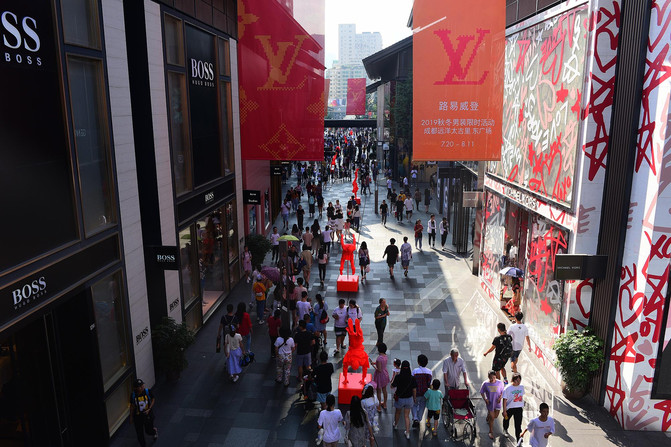
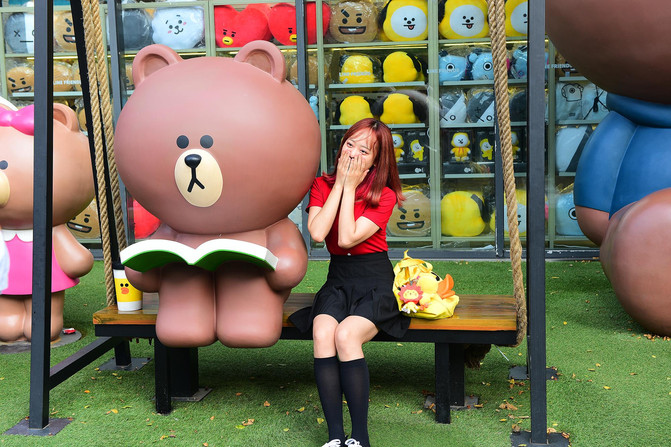

Jiyu-a cost-effective Thai seafood hot pot
What you want to eat, whether it is new Sichuan cuisine, creative Western food, or hot pot skewers, etc., you can find it in Taikoo Li. My parents don't eat much seafood on weekdays, so they happened to be visiting Tai Koo Li and discovered this fishing market. There were a lot of people queuing at the gate at noon. I thought it would be a good restaurant, so I brought them here to try it.


Without thinking, we ordered the four-person set meal of the signature tom yum hot pot, plus the "signature curry shrimp" and several special drinks. The four of us and a child were full.
I especially recommend their four-person set meal. Basically all the seafood varieties you can think of are included, including fresh prawns, freshly opened golden shellfish, wild red shellfish, large oysters, big squid, various shellfish, etc.…I just feel that I have served plate after plate, and even the children have enjoyed it.
The most important thing is that all the seafood is introduced and cooked by the shop assistant. Then, after the seafood in the shell is cooked, they will help peel it off and make it exquisitely and even remove the shrimp line. We and other diners just open their mouths and eat it. We are a little embarrassed by the good service.


His family's "Internet celebrity coconut bowl" has different flavors such as mango and blueberry, and has a high value; while eating hot pot, he uses soft smoothies to combine the spicy taste, which is very comfortable. There are many things in this dessert that will never be eaten. feeling.

He has a baby chair at home, and he can also make smooth seafood noodles for small pots of friends; the snacks in the cart are made in the shape of rabbits, and all kinds of desserts can make children have fun and happy. After eating like this, the average person will be more than 100.

Oyster Hero Self-service Roast Oyster Shop-unlimited consumption of fresh oysters
Speaking of seafood, most foodies cannot conceal their love for raw oysters. Restaurants specializing in raw oysters have also quietly become popular in Chengdu in recent years. On Hongxing Road not far from Tai Koo Li, there is an "Oyster Hero" barbecue restaurant that can eat raw oysters world-shaking.
If you don't want to do it yourself, you can always ask the waiter to help you roast oysters, roast meat, and roast vegetables. As long as you bring the dishes on the table, you don't have to do it. You just need to open your mouth.


Do you hear the sizzling of oysters on the baking sheet? It's just drooling! I heard that the best fresh oysters of Oyster Hero are flown in from Zhanjiang, Guangdong every day because the seawater there is high salinity, the fresh oysters are fat, juicy, clean and have no fishy smell.
Every fresh oyster is served carefully after being carefully cleaned with a high-pressure water gun and clear water before being placed on a special plate in the restaurant and waiting for you to serve it on the table. Therefore, the restaurant also hopes that every guest who comes to eat oysters will not be wasted. The CD is the most glorious.


Here comes the key point. You can eat fresh oysters for just double digits!!! The restaurant also has an original boiled oysters, which is a real test of the freshness of the ingredients. In addition to raw oysters, there are also various meats, vegetables, and desserts that are taken at will. I really don't think I have two stomachs!


When it comes to new-style food, I can't just talk about Taikoi. A friend told me that 98% of Chengdu people don't know that there is a food court hidden in the oak forest opposite Jinhua Wanda, and I must go and get a card. He also mentioned in particular that there were several restaurants there that were particularly good at "eating meat", and then casually recommended one called "Deqi".
Deji Braised Rotisserie--a meat eater's paradise
Chengdu Oak Forest is famous for its house, but not many people know that there is a food court opened there. After all, it is a new place that was only opened last year. However, after visiting Wangjiang Tower, it is really a pleasant thing to come back to the food court to have a barbecue or something.
The store in China Resources 24th City always has to queue up. Take advantage of the fact that not many people know about this new store in Acorn Lane and don't have to wait in line, go quickly and have a meal.


It was not yet 6 p.m. when I went there, so it seemed like we had booked the venue. I have been thinking about the difference between "braised kebabs" and the barbecue we usually eat? It turns out that braising is when chefs hang various kebabs on the inside of a large vat, cover them, and use the temperature of the charcoal fire at the bottom of the pot to braise and roast the kebabs inside the large vat until cooked.
Therefore, when you are ready to eat grilled meat, all you can eat is the meat roasted in the stew pot. The meat is locked in the gravy and delicious, and it is not easy to get angry. The key is that fashionable girls who are afraid of getting their clothes stained with various smells of smoking and roasting are no longer afraid of the smell after eating barbecue.
Prawns, fresh meat, black pepper beef belly strips, chicken wings, signature mutton skewers, roasted steamed buns, roasted vegetarian vegetables, etc... are all very delicious.



After writing this article with drooling, I began to miss my Chengdu again!
Previous Article:Seven Brush Chengdu: A feast about culture, food, and tourism photography
Next Article:I miss the charm that can be seen everywhere in Chengdu
